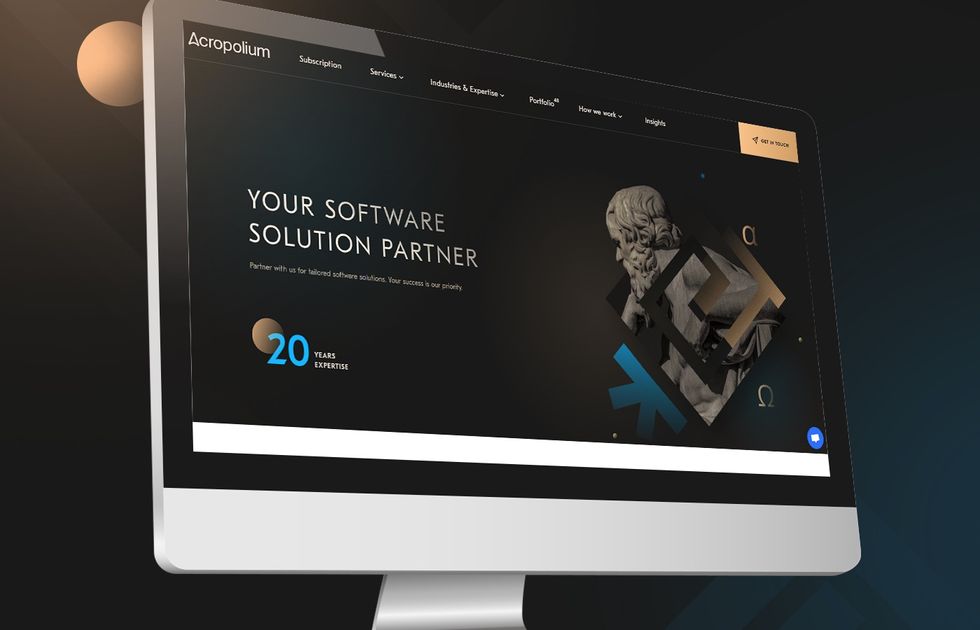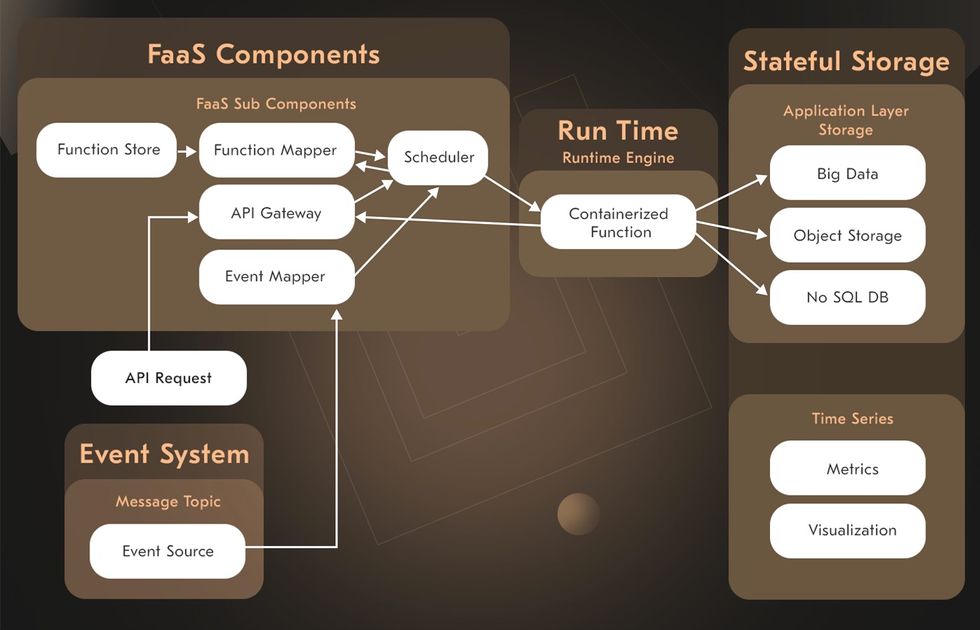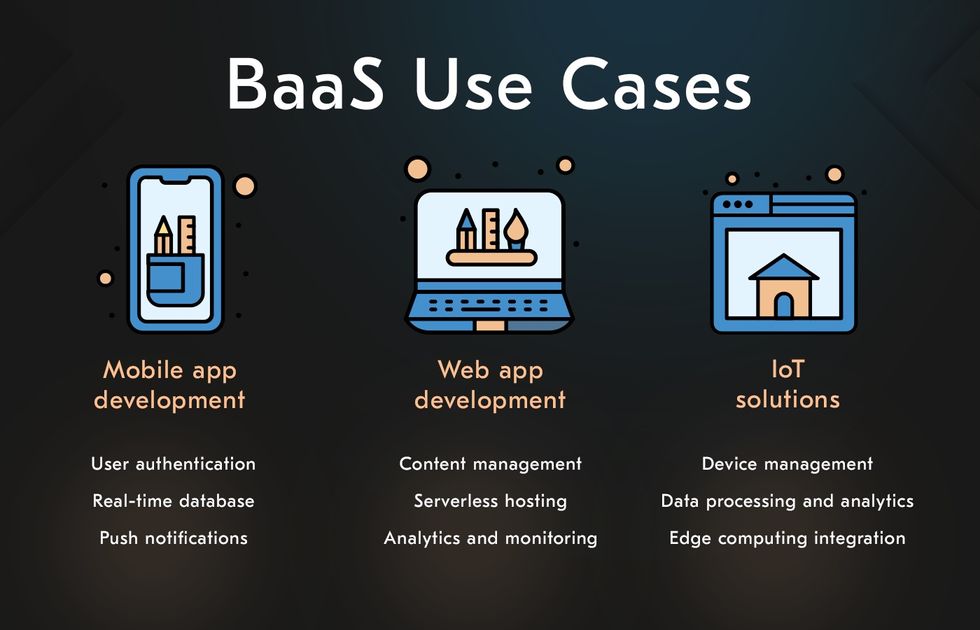
Key takeaways
- If your company requires a comprehensive backend solution with pre-built infrastructure and services like databases and authentication, Backend-as-a-Service (BaaS) is the ideal choice.
- If your business needs to execute specific functions triggered by events or tasks without managing infrastructure, Function-as-a-service (FaaS) is more suitable.
- BaaS offers a comprehensive backend solution with a range of services, while FaaS provides scalability and cost-effectiveness.
The contemporary stage of technological development finally made serverless architectures happen. These models help to build and execute applications and possess numerous advantages to companies, including
- Perfect business implementations and control of infrastructure
- Keeping a better level of management
- Compliance with uptime requirements, plan availability, and SLAs
- Minimizing operational expenses and better budgeting
- Utilizing applications and services from third parties
- Excludes extra personal engagement
In this article, we’ll reveal the peculiarities of two main serverless architectures, known as BaaS (Backend as a Service) and FaaS (Function as a Service). FaaS BaaS cloud computing services serve different aims and have a diverse set of advantages and disadvantages.
BaaS vs FaaS: Key Advantages and Disadvantages
As a BaaS serverless provider, Acropolium has vast experience and portfolio-proven expertise in delivering backend as a service to different industries. Here, we’ll present our vision on high-quality services you can request from your tech partner and reveal all the pros and cons of BaaS and FaaS models.
Let’s start with BaaS advantages:
- BaaS providers offer a wide range of pre-built backend services that cater to various needs. For instance, user authentication, database management, file storage, push notifications, etc.
- Developers can focus more on frontend development tasks like designing user interfaces, enhancing user experience, and optimizing performance rather than building and managing backend infrastructure.
- BaaS relieves developers from the complexities of managing backend infrastructure, including server maintenance, database administration, and scalability concerns.
At the same time, BaaS disadvantages include the following:
- While BaaS offers convenience and efficiency, it may lack the level of customization and control than off-the-shelf coding provides. BaaS solutions often follow a one-size-fits-all approach, which may not fully meet the unique requirements and preferences of every app.
Now, it’s time to briefly overview FaaS advantages:
- FaaS allows developers to break down their applications into small, independent functions that can be executed in response to specific events or triggers. Web app architecture enables automatic scaling without the need to provision or manage underlying infrastructure resources.
- FaaS examples support real-time data processing, enabling apps to react promptly to incoming data streams like user interactions, sensor readings, or external system updates.
In addition to the advantages, FaaS has several disadvantages too:
- Developing and managing complex workflows, stateful applications, or long-running processes in a serverless environment can be challenging due to the inherent limitations and constraints.
- FaaS platforms limit developers’ control over aspects like resource allocation, networking configurations, and runtime environments. This can be a drawback for applications with specific performance, security, or compliance requirements.
We’ve summarized the main differences function as a service vs backend as a service:
| Advantages | Disadvantages | |
|---|---|---|
| BaaS (Backend as a Service) |
|
|
| FaaS (Function as a Service) |
|
|
The table to compare BaaS vs FaaS models
Differences between BaaS and FaaS

Mainly, the difference between BaaS and FaaS is the purpose of adoption.
BaaS deals with backend functionality as a whole, but serverless FaaS addresses microservices in applications only, responding to the events that occur. That’s why the set of technologies that make FaaS vs BaaS work is so different.
Among other differences between FaaS and BaaS, unequal functionality complexity is striking.
Since BaaS addresses numerous backend frameworks, it contains the necessary pieces of low code to build push notifications, geolocation, email verification, and many other functions. In its turn, function as a service examples cannot address complex tasks but provide the needed speed and accuracy in managing microservices.
What is BaaS (Backend as a Service)
In essence, BaaS is an innovative cloud model widely adopted for developing mobile apps and websites alike. This way, the execution model saves time for your team for numerous other tasks rather than testing and deployment.
The BaaS market, valued at $5.7 billion in 2022, is expected to reach $31.1 billion by 2030, growing at a CAGR of 23.6% during the forecast period. It is driven by the increasing demand for scalable and cost-effective solutions, coupled with the rising adoption of cloud-based technologies across various industries.

Among the concrete functions backend developers can deliver quickly — BaaS offers assistance to database management, push notifications, user authentication. Being applicable to game apps, single-page applications, websites, chatbots, and various industrial apps, it grants you access to a bundled infrastructure with ready-to-use APIs and SDKs behind.
Recently, there appeared mBaaS, or mobile Backend as a Service, that addresses the backend tasks for mobile application development. Like classic BaaS, mBaaS lets you maintain only the frontend part, totally supporting the backend services in a mobile app.
Pros of BaaS

What advantages encourage companies to turn to multi-tenant BaaS solutions?
- With pre-built services, BaaS helps reduce costs associated with server provisioning, database setup, and ongoing maintenance.
- BaaS platforms offer a wide range of ready-to-use services and features, so developers focus on building core application features and delivering value to users without reinventing the wheel.
- BaaS providers typically offer flexible pricing plans tailored to the needs of different projects and businesses. You can choose the pricing tier that best suits your requirements, whether you’re working on a small personal project or a large enterprise application.
- BaaS solutions enable companies to build applications seamlessly running on multiple devices and platforms, including web browsers, mobile devices, IoT devices, and more.
- BaaS vendors continuously update their services and features to incorporate the latest technological advancements, strong security, and performance. Leverage trending innovations in backend development and stay competitive.
- With BaaS, you handle increasing loads and user traffic without experiencing downtime or performance issues. Seamlessly scale your applications up or down based on demand.
- BaaS platforms often include features like data encryption, authentication, authorization, and compliance certifications to protect user data and mitigate security threats.
Cons of BaaS
Nothing is perfect, so let’s talk about FaaS limitations:
- Like any tailor-made solution, this service is not adjustable as custom coding. Some packages and platforms offer the ability to add your own feature to overcome this limitation, though.
- Vendor lock-in presents a significant challenge for developers utilizing BaaS platforms, hindering their ability to migrate seamlessly between providers.
Top BaaS Providers
On the market, several tech providers are offering high-quality BaaS services. Choosing from various BaaS examples, you must come from your needs and nothing else.
Acropolium

Acropolium possesses years of experience in delivering web and mobile solutions, which lets the company understand the typical business requests and standard functions. To sum it up, the tech vendor has created its own BaaS platform with a set of pre-built blocks. Clients can build websites, craft SaaS solutions, create builders, and manage workflows with the platform.
Firebase

Firebase supports many projects from this search engine giant and lists several demanded backend features, including analytics, authentication, and push notifications. The special set of functions from Firebase includes ready-to-use APIs from text recognition, landmark recognition, and image labeling.
AWS Amplify

Amplify, an Amazon BaaS platform, streamlines web and mobile app development with secure, easy-to-deploy solutions. It offers AI/ML, analytics, API management, CDN, and other capabilities. One notable aspect of Amplify is its use-case-centric libraries and frameworks, making adding cloud-based features tailored to specific app needs easier.
Backendless

Backendless is an open-source SDK with limited BaaS functionality. Local and cloud hosting allows you to get authentication, social login, push notification, geofencing, data import and export, and analytics. The payment plans are different, depending on the number of features available.
What is FaaS (Function as a Service)
Let’s start with a FaaS meaning. FaaS is a serverless approach with ready-made pieces of code. It’s useful for developers to work on the fly or respond to the events and provide microservices.
The platform enables running self-contained functions (or already designed code snippets) in the cloud. Being an event-based model, FaaS frees your developers from executing the code and lets them work on other important tasks.

Pros of FaaS
FaaS solutions also have many advantages to consider:
- Developers can focus solely on writing application logic and building applications without configuring or managing servers. It leads to faster development cycles and accelerated time-to-market for applications.
- The greatest strength of FaaS is cost-effectiveness. With the already designed codes, you can save significant resources on creating them from scratch.
- FaaS providers automatically scale resources based on demand, ensuring apps can handle varying usage volumes.
- FaaS relieves developers from the burden of server hosting, management, and maintenance tasks. That means they focus on application development without worrying about infrastructure management.
- Also, FaaS is useful for the real-time processing of data. Your developers don’t need to interact with page elements to update the code. They only need to pick a temporarily running container in the existing pod. These ephemeral containers provide smooth user integrations and manage workloads and troubleshooting optimally.

Cons of FaaS
Be careful if these FaaS disadvantages are critical to your business:
- FaaS doesn’t address the core business aims of your business. It can help you maintain and manage some micro-events, but it does not apply to complex backend tasks.
- The FaaS platforms, by automatically running your code without asking you for provision, create a sense of the lack of control. This is especially critical in crisis events when the company has to get manual access to the infrastructure.
- Developers may face constraints in design and customization as infrastructure management lies with the provider. Those seeking more control may find alternatives like BaaS more suitable.
- Transferring FaaS code to local test environments can be challenging. This complexity can hinder efficient app testing and debugging, impacting development timelines and budgets.
Top FaaS Providers
Azure, Google, and AWS are the biggest FaaS providers that concentrate on configurability. It means that their services are closely linked to other parts of their ecosystem.
AWS Lambda

This serverless compute service from Amazon lets you run code without provisioning and managing servers. The set of benefits includes the complete absence of servers to manage, continuous scaling, cost optimization with millisecond metering, and consistent performance at any scale.
Azure Cloud Functions

Azure Functions can solve complex orchestration problems that appear in your Azure computing environment. The set of functions includes automated and flexible scaling based on your workload volume, integrated programming volume based on triggers and bindings, end-to-end development experience, and a variety of programming languages and hosting options.
Google Cloud Functions

This service lets you treat all Google and third-party cloud services as building blocks, running your code with zero server management. The features include simplified developer experience and increased velocity, pay only for what you use, and avoidance of lock-in with open technology. The exact pricing for this FaaS solution depends on how long your function runs, how many times you use it, and how many resources you provision.
Why Choose BaaS over FaaS
The question of choosing backend as a service vs function as a service has a straightforward answer. It’s better to pick BaaS because it addresses more complex tasks and delivers more sophisticated results:
Common BaaS use cases include:
- BaaS is widely used in mobile app development to offload backend infrastructure management tasks like user authentication, real-time databases, and push notifications.
- BaaS platforms provide pre-built backend services like content management, analytics and monitoring, and serverless hosting, enabling developers to rapidly prototype and deploy web app solutions. It is especially popular among startups and small businesses with limited resources who may fail.
- BaaS can streamline the development of Internet of Things (IoT) applications by providing cloud-based backend services for device management, data processing and analytics, and integration with edge computing solutions.

Getting the platform is cheaper than hiring a skilled backend engineer. For example, a BaaS provider managed to save $500k for a Vantage SaaS company.
For reaching the maximum benefit from picking BaaS FaaS provider, ensure your tech vendor can deliver this list of components:
- APIs
- Database
- Cloud Code Functions
- Infrastructure
- Content Delivery Network
- Caching
- Geolocation
- User authentication
- Third-party integrations
- Social integration
- Push notifications
- Data management
In addition, check if a serverless vendor is compliant with GDPR and HIPAA.
BaaS Development: Use Case from Acropolium
A German startup required a stress-less app, a mobile cross-platform social network app that discards all possible stressful experiences. After eliminating the technical debt and reengineering to optimize infrastructure, the client got:
- An effective wellness social media mobile app created with tight deadlines;
- Reduced costs on software engineering by 40%;
- Decreased by 50% budget of mobile development.

Contact Acropolium for BaaS Services!
BaaS development solutions from Acropolium will help you save up to 75% on the costs and accelerate the time to market twice!
Our services are applicable to scalable database management, cloud storage, user authentication, push notifications, hosting, APIs, email verification, geolocation, gateway, and infrastructure.
The list of custom solutions we’ve already delivered is also wide, including an addiction recovery mobile app, dental clinic mobile app, location-based social network app, and restaurant chatbot.
Get our consultation on BaaS implementation now! Acropolium dedicated experts are ready to answer all your questions, mitigate risks, and guide you through the development (or legacy system modernization) process.









![Most Popular Backend Frameworks in 2025 [What to Choose]](/img/articles/most-popular-backend-frameworks/img01.jpg)


![Reduce Time to Market: [11 Ways] to Speed Up Product Development](/img/articles/reduce-time-to-market/img01.jpg)

![Modern Web Application Architecture in 2025: [Build a High-Performance App]](/img/articles/modern-web-app-architecture/img01.jpg)